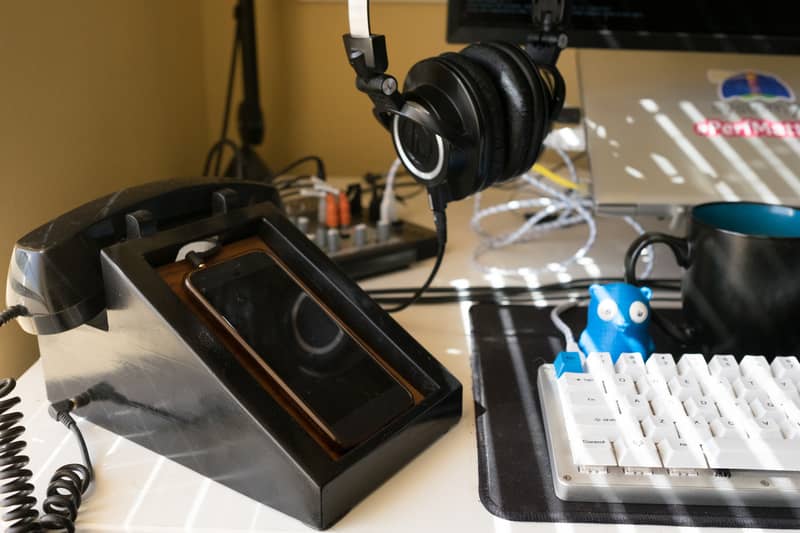If there is one thing this pandemic has reminded me of is that talking on the phone is a lost art. In an era where the need to have nimble thumbs to type out messages while taking selfies has high societal value, the phone call signals impending doom. I call people and there is a shock and at times a bit of anger. Just send a text Justin, I’m busy being locked in my house trying to dress this cat in a suit. Danger at every ring.
I remember talking on the phone as a kid fondly, being enamored of friends who had their own personal line in their rooms. To have a phone you could talk to people and dial into a internet, that was the dream.
Talking on the phone today, outside the taboo never-call-me-ever notion, is a terrible experience because today’s mobile phones are not designed to be good experiences for, you know, being a phone. Sure, who uses them for that (“that’s why we have Airpods Dad”) but that hasn’t stopped me from wanting a phone that I can talk on.
One evening, I found myself watching Jerry Lewis in the classic film The Bellboy grabbing and popping hefty phone receivers. The scene is a master class in comedy and Mr. Lewis' genius, but will lead you down a dark road.
Yeah, I could be funny with a phone. I need that kind of phone.
Out to the shop I went, digging through boxes of parts looking to modify an of existing Model 500 (who doesn’t have one or six or too many that yours kids are embarrassed to be seen with you), but turns out the dimensions simply would not work. I was going to have to do this the hard way. I gave myself three requirements:
- I have to be able to walk around with it, so it has to have a receiver hook to put your fingers under.
- It’s going to have to have some heft otherwise it won’t feel right
- Off the shelf handset, if available, otherwise gut one and wire it (which I did find in four packs, oddly enough)
Having set forth my goal, I started by sketching out some of the initial dimensions based on photographs and the phones I had available. Taking some measures and then finding a reasonable ratio I settled on something in the middle with a little wiggle room, particularly on the length and height which need to accommodate the phone at a reasonable pitch.
Having done the math, I settled on a split cut to make finishing and assembly a little simpler. I also highly gutted the inner supports to save on both print time and filament. In the models below, I’ve put them on their sides to make the inner supports a little easier to see (I did not print them this way).
I fired up the Airwolf AXIOM with it’s giant build plate and set forth to let it print.
An aside: I’ve had one of the AXIOMs for over three years and like most 3D printers I’ve worked with, it’s one of those love-hate relationships. That said I’ve had very good luck with it printing large parts, of which it is well suited.
Given the size and not needing these immediately, I set the various parts up to print in overnight runs, giving me a whole bunch of parts to sand and finish. I printed them in the available ABS I had in various colors (orange and black), which meant that I could use acetone to bind any relevant parts and hit it was the sander.

The inner phone seat, seen below in the exploded parts version, was initially finished with a black plastic seen in my test copy. I didn’t care for it; it lacked style and the finish was meh in my opinion.

I settled instead on a thin oak plank cut to shape and some cyano glue to create a nicely finished look. The end result was pleasing on my desk, and even better to use.

The weight is still off as I didn’t shape the bottom base plate as originally planned (I had to move on to some other projects), but the overall ergonomics is lovely. I do believe I’ll cut a piece of thin plate to affix to the bottom through some mounted inner screw mounts (similar to a model 500’s plate), but in the mean time, both the prototype and the finished version are in heavy use (and I still have two more copies to finish).
There are other additions to do of course. I think the next iteration will probably have wireless charging and bluetooth (if only for the ease of drop-and-talk, even if I do “wire” the handset). But for now, my four year old set of Pixels (yeah, still rocking the original) and it’s 3.5mm headphone jack rule the day.
Overall it’s made my phone talking experience that much better, even if the majority of people don’t want to talk on the phone. 😁
If you’d like to attempt a print of this, the files are located in my Github repo justinribeiro/we-model-500-phone-stand.

